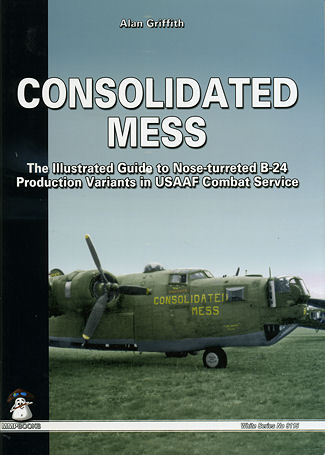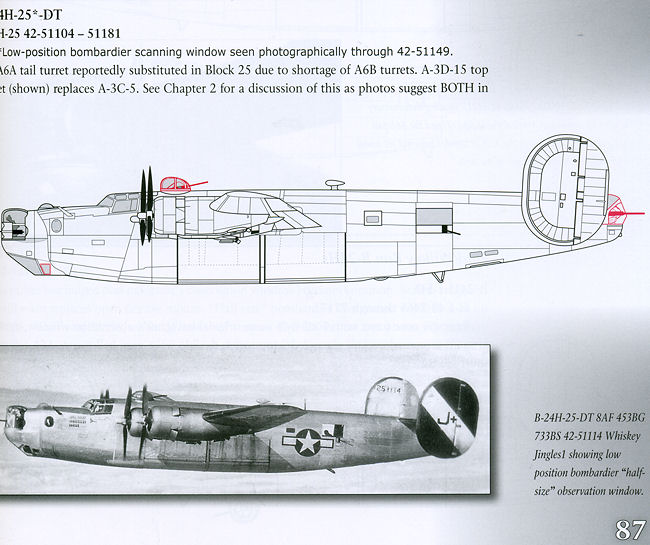MMP's
Consolidated Mess:
A guide to nose turreted B-24 production variants
|
Author: |
Alan Griffith |
|
Publisher |
Mushroom Models
Publications |
|
Price |
£24.99 MSRP ($59.99 from the US
distributor) |
|
Reviewer: |
Scott Van Aken
|
|
Notes: |
#9115
ISBN 978-83-61421-16-0 |
 It was a few
years back when I was researching building a B-24 model that I came to realize
that to do a totally accurate B-24, one had to really know their stuff. There
was a myriad of differences in terms of turrets used, window size and type as
well as other small things like the direction of the retraction of the nose gear
doors. Little did I realize that this is only the tip of the iceberg with planes
manufactured by Consolidated as well as those built by Ford being so different
in their parts that units operating planes made by both manufacturers had to
pretty well have two parts chains. Many of the seemingly same parts were not
interchangeable. As the title suggests, it is quite a maze and one that no one
had been able to successfully master.
It was a few
years back when I was researching building a B-24 model that I came to realize
that to do a totally accurate B-24, one had to really know their stuff. There
was a myriad of differences in terms of turrets used, window size and type as
well as other small things like the direction of the retraction of the nose gear
doors. Little did I realize that this is only the tip of the iceberg with planes
manufactured by Consolidated as well as those built by Ford being so different
in their parts that units operating planes made by both manufacturers had to
pretty well have two parts chains. Many of the seemingly same parts were not
interchangeable. As the title suggests, it is quite a maze and one that no one
had been able to successfully master.
That has now all changed. Author Alan Griffith
has done a herculean task of rounding up documents and photographs to put
together the complex puzzle of which aircraft was equipped with what in terms of
things like nose turrets, tail turrets, upper fuselage turrets, lower turrets
(or lack of), and side gun openings. This also includes a bewildering number of
modifications to navigator and bombardier windows as well as smaller details
such as tail bumpers/wheels, pitot tube mounts, and nose gear doors. Add to that
differences in windscreens and the length of engine nacelles in late B-24s and
you can see that things are not as simple as they might seem.
Early in the war, particularly in the Pacific
where the B-24 was the defacto heavy bomber until the B-29 showed up, combat
with the Japanese showed the need for changes. Most of these changes were made
at Air Depots in Hawaii and Australia as well as some in the US prior to
modifications being introduced on production lines. The biggie was the nose
turret. Japanese fighters always attacked from the front and from below as that
is where there was the least chance of getting hit by return fire. While the
B-24 had a turret in the belly, it was not all that effective and often removed
and replaced with what was essentially a twin gun Scarff ring. In the nose, a
tail turret was grafted on as an experiment. While it greatly improved defensive
protection, it also cramped up the navigator's position. An unexpected benefit
is that it decreased the tail heaviness of the B-24 and improved performance!
More improvements were made in Pacific B-24s by eliminating the tail turret and
putting in a pair of hand held .50s in an open housing.
This was the beginning of the many mods and
updates made to these planes. I'd tell you more, but that would sort of ruin the
fun of discovering much of this by reading the book.
 Some of the
major sections of the book are on the modifications done by the various Air
Depots, This then goes into what are titled 'Fiddly Bits', those windows and
canopy glazing I mentioned earlier. Then there is a look at North American
produced B-24Gs, Ford produced B-24Hs (by the way, Ford was so efficient at
producing B-24s that the supply far outstripped the ability of the USAAF to
absorb the new builds), and sections on the B-24J, B-24L and B-24Ms. Privateers
are not covered and will be in another volume.
Some of the
major sections of the book are on the modifications done by the various Air
Depots, This then goes into what are titled 'Fiddly Bits', those windows and
canopy glazing I mentioned earlier. Then there is a look at North American
produced B-24Gs, Ford produced B-24Hs (by the way, Ford was so efficient at
producing B-24s that the supply far outstripped the ability of the USAAF to
absorb the new builds), and sections on the B-24J, B-24L and B-24Ms. Privateers
are not covered and will be in another volume.
There are appendices on Paint recognition
features (complete with diagrams), B-24 Serials, Known Air Depot mods, the never
built B-24'Zwilling', Bomb bay door structure, Experimental turrets, and a
section on the B-24N.
The book is simply crammed with photos used to
illustrate the various mods as well as excellent drawings that highlight what
has been changed. I have included a sample section of one page to show what I
mean.
MMP has a deserved reputation for providing
superbly researched and usable books that are a delight for both the enthusiast
and modeler. This one has raised that bar another notch in terms of the amount
of research done and the sheer wealth of information that has been provided. It
is an absolute must have for any modeler and a book that gets my highest
recommendation. You need to get this one before it sells out.
March 2012
Review book courtesy of Mushroom Models Publications
where you can order your copy. Australian readers can get theirs from
Platypus Publications, while US readers can visit
Casemate Publishing for
theirs when the book arrives in April.
If you would like your product reviewed fairly and fairly quickly, please contact the editor or see other details in the Note to
Contributors.
 It was a few
years back when I was researching building a B-24 model that I came to realize
that to do a totally accurate B-24, one had to really know their stuff. There
was a myriad of differences in terms of turrets used, window size and type as
well as other small things like the direction of the retraction of the nose gear
doors. Little did I realize that this is only the tip of the iceberg with planes
manufactured by Consolidated as well as those built by Ford being so different
in their parts that units operating planes made by both manufacturers had to
pretty well have two parts chains. Many of the seemingly same parts were not
interchangeable. As the title suggests, it is quite a maze and one that no one
had been able to successfully master.
It was a few
years back when I was researching building a B-24 model that I came to realize
that to do a totally accurate B-24, one had to really know their stuff. There
was a myriad of differences in terms of turrets used, window size and type as
well as other small things like the direction of the retraction of the nose gear
doors. Little did I realize that this is only the tip of the iceberg with planes
manufactured by Consolidated as well as those built by Ford being so different
in their parts that units operating planes made by both manufacturers had to
pretty well have two parts chains. Many of the seemingly same parts were not
interchangeable. As the title suggests, it is quite a maze and one that no one
had been able to successfully master. Some of the
major sections of the book are on the modifications done by the various Air
Depots, This then goes into what are titled 'Fiddly Bits', those windows and
canopy glazing I mentioned earlier. Then there is a look at North American
produced B-24Gs, Ford produced B-24Hs (by the way, Ford was so efficient at
producing B-24s that the supply far outstripped the ability of the USAAF to
absorb the new builds), and sections on the B-24J, B-24L and B-24Ms. Privateers
are not covered and will be in another volume.
Some of the
major sections of the book are on the modifications done by the various Air
Depots, This then goes into what are titled 'Fiddly Bits', those windows and
canopy glazing I mentioned earlier. Then there is a look at North American
produced B-24Gs, Ford produced B-24Hs (by the way, Ford was so efficient at
producing B-24s that the supply far outstripped the ability of the USAAF to
absorb the new builds), and sections on the B-24J, B-24L and B-24Ms. Privateers
are not covered and will be in another volume.